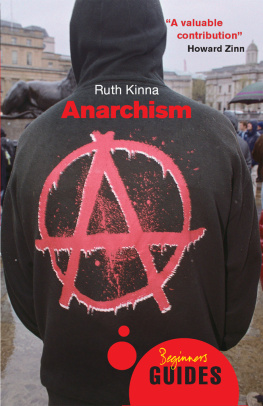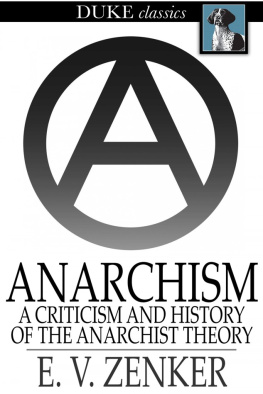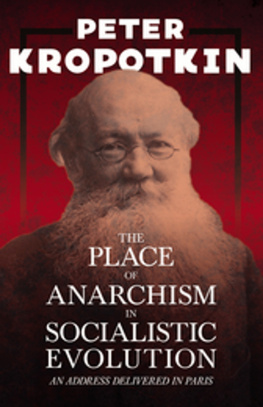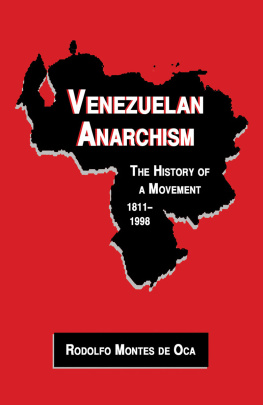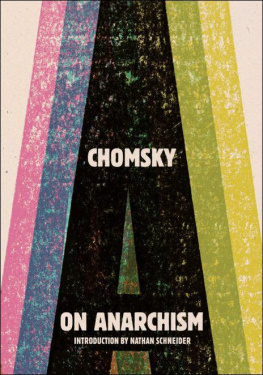RUTH KINNA
The Government
of No One
The Theory and
Practice of Anarchism
A PELICAN BOOK

PENGUIN BOOKS
UK | USA | Canada | Ireland | Australia
India | New Zealand | South Africa
Penguin Books is part of the Penguin Random House group of companies whose addresses can be found at global.penguinrandomhouse.com.

First published in 2019
Text copyright Ruth Kinna, 2019
The moral right of the author has been asserted
Book design by Matthew Young
Cover by Matthew Young
ISBN: 978-0-141-98467-4
This ebook is copyright material and must not be copied, reproduced, transferred, distributed, leased, licensed or publicly performed or used in any way except as specifically permitted in writing by the publishers, as allowed under the terms and conditions under which it was purchased or as strictly permitted by applicable copyright law. Any unauthorized distribution or use of this text may be a direct infringement of the authors and publishers rights and those responsible may be liable in law accordingly.
Acknowledgements
A number of people have contributed to the writing of this book by commenting on drafts, helping locate information and providing examples of anarchist practice. First and foremost, thanks to Casiana Ionita for reading the text so closely and giving excellent advice about the presentation of the arguments; Robert Knight for comments on the first draft and suggestions for finessing the text and Claire Pligry for scrupulous, helpful editing. Peter Ryley shared his knowledge of Henry Seymour. Special thanks too to the independent researcher and visual artist Daniel Huckfield for his meticulous work on Seymours life. Natasha King helped me think about power and privilege and Marina Maximova, Robert Graham and Andrew Cornell assisted with research on hard-to-find activists.
INTRODUCTION Anarchism Myths and Realities
In 1999 activists in Seattle spectacularly sabotaged the meeting of the World Trade Organization. The event launched what became known as the alterglobalization or global justice campaign, a complex, anti-capitalist movement of movements widely described as anarchist. The same year, James Bond went head-to-head with Victor Zokas aka Renard in the movie The World Is Not Enough. Renard, an ex-Soviet army and KGB officer, brutal even by the standards of Bonds antagonists, is also reportedly anarchist. His back story tells how he worked as a freelance assassin for anti-capitalists organizing before the alterglobalization movement fell under the media spotlight.
On one level, it is easy to distinguish the fact from the fiction. Renard is an invention of scriptwriters and movie-makers. The Seattle shutdown of the WTO is documented history. Yet on another level, the attribution of the anarchist label to both the killer and the street movement is confusing: the fiction appears to capture something about the reality. Film-goers may have to suspend their disbelief about the bullet permanently lodged in Renards brain, but the emotional instability his injury explains and which underpins his anarchism hardly seems demanding. On the contrary, his ruthlessness and single-mindedness play to a deeply rooted view of anarchism which continues to influence public analysis of activist movements. Admittedly, the anarchism of the alterglobalizers was not automatically condemned as sadistic, aggressive or vengeful, but leading politicians of the time commented on the dangerous mix of vandals and carnival clowns it attracted: the movement was by turns dismissed as unbalanced and unthinking. And once street protests resulted in property damage, as in Gothenburg in 2001, it was possible for authorities to mobilize against the anarchists in its ranks. Both before and since, the use of the A word has provided a green light to aggressive policing. The global justice movement was no exception. The protesters who converged in Genoa in 2001 for the meeting of the G8 met with savage police violence.
The cultural stereotypes of the anarchist that furnish Renards characterization are not only distorting, they are also disabling. They conceal a history of critique and resistance that is empowering and normalize practices that are discriminatory and oppressive, even in instances where unfairness and injustice are patently obvious and widely acknowledged. Being anarchist means challenging the status quo to realize egalitarian principles and foster co-operative, non-dominating behaviours. Anarchist actions can take multiple forms, many of which are easily absorbed into everyday life. As we will see in the following pages, Renard is far from being anarchisms default setting.
Thinking like an anarchist
In 1919 the sculptor and printmaker Eric Gill wrote to the Burlington Magazine to protest Sir Frederic Kenyons proposals to the Imperial War Graves Commission. The Commission had been established in May 1917 to identify the graves of soldiers who had already been buried and to record the deaths of those who had no known grave. At the end of the war three notable architects, Sir Edwin Lutyens, Sir Herbert Baker and Sir Reginald Blomfeld, were invited to design the war cemeteries. Kenyon, Director of the British Museum, was appointed to give coherence to the architectural plans. In his November 1918 report he urged the War Graves Commission to adopt the principle of equality. As Kenyon put it, what was done for one should be done for all, and that all, whatever their military rank or position in civil life, should have equal treatment in their graves. In practice, equality demanded that the Commission be given responsibility for the design of the individual memorials, as well as the layout of the cemeteries. Provision could not be left to individual initiative because satisfactory results were only likely to be obtained where money and good taste were not wanting. In most cases there was a risk that no monument would be erected, or that it would be poor in quality. The cemeteries would end up looking like English churchyards: jumbled masses of monuments. The effect would be neither dignified nor inspiring and the sense of comradeship and of common service would be lost.
Coupling equality with regularity, Kenyon recommended individual headstones record the name, rank, regiment and date of death of each soldier. Families would be able to include a form of words from a limited set of standard inscriptions but denied free scope for the effusion of the mortuary mason, the sentimental versifier, or the crank, for this too would compromise the military idea, which was to give the appearance of a battalion on parade and suggest the spirit of discipline and order which is the soul of an army. Kenyons major concession to variety in uniformity was to suggest that the appropriate regimental badges be automatically incorporated on the headstones.
Gill objected to the totality of Kenyons vision and linked his corrupted egalitarianism to the mass production processes that architectural integrity implied. The War Graves Commission was right to seek the advice of architects but should never have given them leadership. The designing of monuments is properly the business of those who make monuments sculptors and tombstone makers. As a stone mason himself, Gill clearly had a vested interest in securing some of the contracts the War Graves Commission might have awarded, but his argument was about the social relationships that craft work sustained. Had the War Graves Commission given sculptors the task of engraving the headstones, it would have realized Kenyons egalitarian aims and been far better equipped to take account of the sentiment of the nation, poor as well as rich. His complaint centred on power and ownership:


